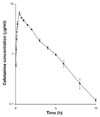1. Arret B, Johnson DP, Kirsbaum A. Outline of details for microbiological assays of antibiotics: second revision. J Pharm Sci. 1971. 60:1689–1694.

2. Atef M, Ramadan A, Afifi NA, Youssef SAH. Pharmacokinetic profile of cefotaxime in goats. Res Vet Sci. 1990. 49:34–38.

3. Baggot JD. The Basis of Veterinary Clinical Pharmacology. 1977. Philadelphia: Saunders;144–189.
4. Benet LZ, Kroetz Dl, Sheiner LB. Hardman JG, Limbird LE, Gilman AG, editors. Pharmcokinetics: The dynamics of drug absorption, distribution and elimination. Goodman and Gilman's The Pharmacological Basis of Therapeutics. 1996. 9th ed. New York: McGraw Hill;3–28.
5. Dutta BP, Debnath SC, Mandal TK, Chakraborty AK. Modification of pharmacokinetics of cefotaxime in uranyl nitrate-induced renal damage in black bengal goats. J Vet Sci. 2004. 5:1–3.

6. Gibaldi M, Perrier D. Pharmacokinetics. 1982. New York: Marcel Dekker;433–444.
7. Guerrini VH, English PB, Filippich LJ, Schneider J, Bourne DWA. Pharmacokinetics of cefotaxime in the dog. Vet Rec. 1986. 119:81–83.

8. Guerrini VH, Filippich LJ, Cao GR, English PB, Bourne DWA. Pharmacokinetics of cefaronide, ceftriaxone and cefoperazone in sheep. J Vet Pharmacol Ther. 1985. 8:120–127.

9. Guerrini VH, Filippich LJ, English PB, Bourne DWA. Pharmacokinetics of Cefotaxime in sheep. Am J Vet Res. 1983. 44:1488–1491.
10. Hakim L, Bourne DWA, Triggs EJ. Disposition of cefotaxime and its metabolite, desacetylcefotaxime, in rat: application of a phgrmacokinetic-protein binding model. Xenobiotica. 1989. 19:743–754.

11. Kampf D, Borner K, Moller M, Kessel M. Kinetic interactions between azolocillin, cefotaxime and cefotaxime metabolites in normal and impaired renal function. Clin Pharmacol Ther. 1984. 35:214–220.

12. Knudsen JD, Fuursted K, Frimodt-Moller N, Espersen F. Comparison of the effect of cefepime with four cephalosporins against pneumococci with various susceptibilities to penicillin, in vitro and in mouse peritonitis model. J Antimicrob Chemother. 1997. 40:679–686.

13. McElroy D, Ravis WR, Clark CH. Pharmacokinetics of cefotaxime in the domestic cat. Am J Vet Res. 1986. 47:86–88.
14. Neu HC. The in vitro activity, human pharmacology, and clinical effectiveness of new beta-lactam antibiotics. Annu Rev Pharmacol Toxicol. 1982. 22:599–642.

15. Notari RE. Biopharmaceutics and Clinical Pharmackinetics. 1980. 3rd ed. New York: Marcel Dekker;45–106.
16. Sharma SK, Srivastava AK. Pharmacokinetics and dosage regimen of cefotaxime in cross-bred calves following single intramuscular administration. Vet Res Commun. 1994. 18:313–318.

17. Sharma SK, Srivastava AK, Bal MS. Disposition kinetics and dosage regimen of cefotaxime in cross-bred male calves. Vet Res. 1995. 26:168–173.
18. Sharma SK, Srivastava AK, Deore MD. Pharmacokinetic disposition of cefotaxime in buffalo calves (Bubalus bubalis) following single intramuscular administration. Indian J Anim Sci. 2004. 74:590–593.
19. Simon HJ, Yin EJ. Microbioassay of antimicrobial agents. Appl Microbiol. 1970. 19:573–579.







 PDF
PDF ePub
ePub Citation
Citation Print
Print




 XML Download
XML Download